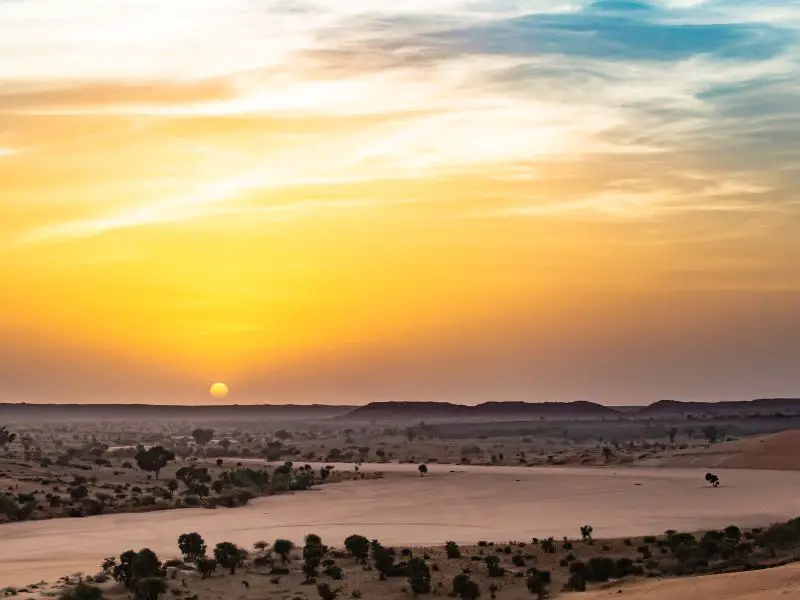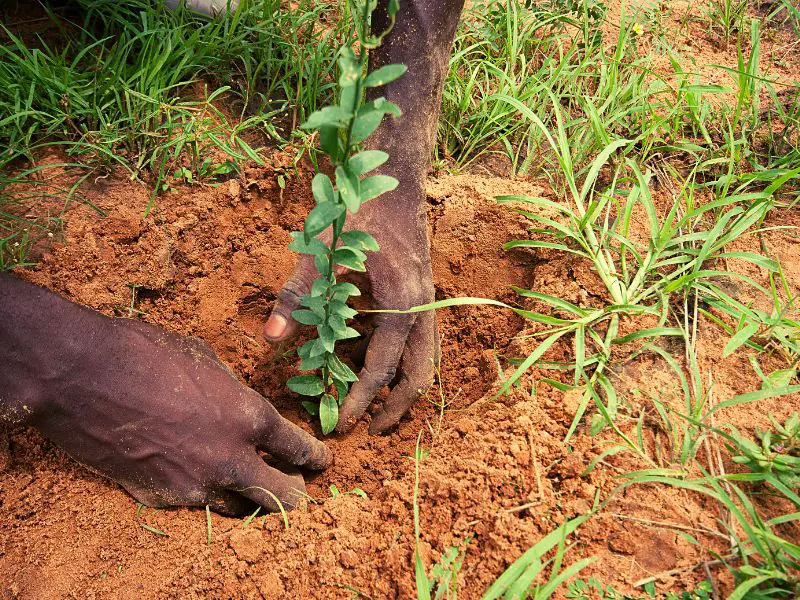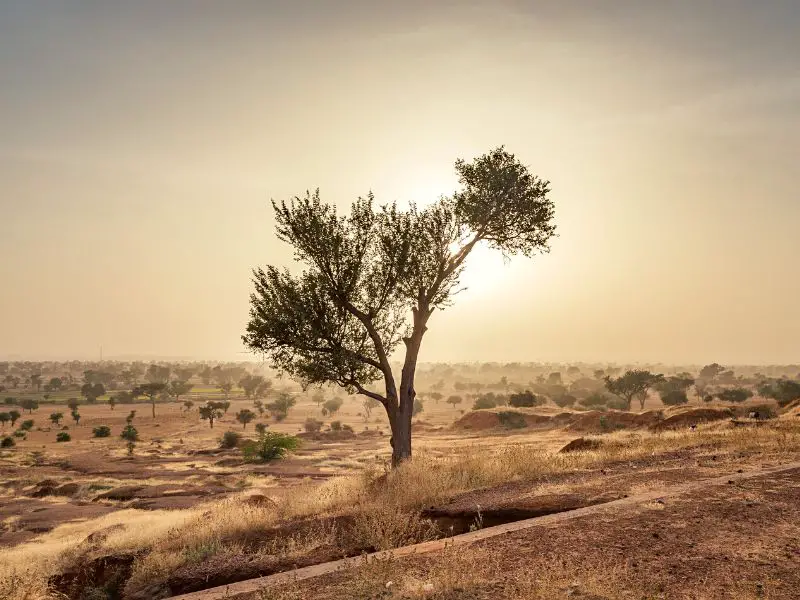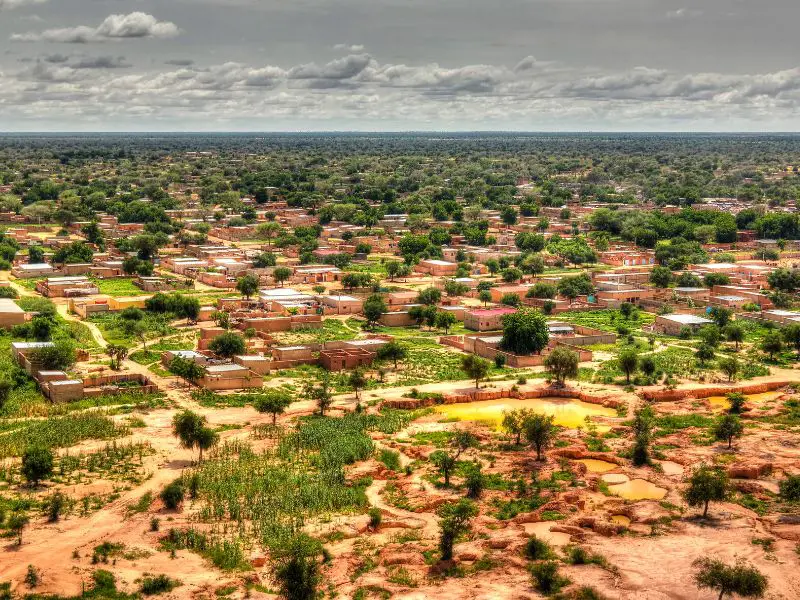The concept of a “great green wall” was initially formed in the 1970s, when climate change, population increase, and unsustainable land management caused severe and persistent droughts in the once-fertile Sahel area of Africa. To rehabilitate the devastated landscapes of the Sahel, eleven African presidents joined the “Great Green Wall” project in 2007, with ambitions to plant an 8,000 km corridor of trees across the continent’s breadth, from Senegal in the west to Djibouti in the east.

Fifteen years later, 21 African nations have joined the enormous project, and around 18 percent of the wall is complete. Over 12 million trees are planted in Senegal, and 15 million hectares of land are rehabilitated in Ethiopia. The plan seeks to repair 100 million hectares and store 250 million tons of carbon dioxide by 2030.
Growing and Thriving More Than Planting Trees
The vast green wall aims to enhance the lives of millions of people in the Sahel area by cultivating fertile soil and combating desertification. Key objectives include:
- The creation of 10 million new jobs
- The improvement of food and water security
- The provision of access to renewable energy
- The empowerment of women through new opportunities
- The reduction of out-migration from the region
- The enhancement of resilience to drought and climate change.

Saving the Sahel
Sahel today is one of the driest places on Earth; its soil is severely degraded by erosion and overgrazing. Under these harsh conditions, the height of young Sahelian trees is stunted and shorter than the average tree height.
Land degradation severely affects the 250 million people who live in the Sahel, a swath of tropical and subtropical grasslands and savannas stretching from Senegal to Djibouti in northern Africa. “Without the Great Green Wall, the Sahel area as we know it may vanish,” African Development Bank President Akinwumi Adesina said at a donor conference earlier this year.
Why Does the Sahel Need Help With the Threat of Desertification?
Desertification is the destruction of productive land. This may result from drought, overcrowding, overfarming, deforestation, or climate change. The consequences of desertification may be observed in many regions of the globe, although they are most prevalent in India, Australia, Asia, and Africa. Each year, desertification transforms about six million acres of land in India into a desert-like condition.

The United Nations estimates that around 30 million acres of land are affected by desertification annually. The most susceptible region is a 3,000-mile length of territory in Africa’s Sahel region that comprises ten countries.
The Sahel region is in between the Sahara Desert and the Sudanese Savannah. Due to recurrent droughts and soil erosion, this region is under continual stress. A thick forest may devolve into a dust bowl in a couple of years, forcing massive migrations. In quest of rich land, Africans usually travel south.
How the “Great Green Wall” Is Helping Us Fight Climate Change
The Great Green Wall initiative is not only an African problem. It is a global problem, It demonstrates the vital link between forests and sustainable development. Climate change and the degradation of the environment are not only threats to biodiversity; they are a threat to the very survival of human beings.
The wall will also serve as a frontline against climate change, showcasing to the rest of the globe what can be accomplished when nations unite to combat humanity’s greatest peril.
The Great Green Wall will help to fight climate change in several ways. It can help to reverse land degradation in drylands and to conserve biodiversity. It can help guard against floods and droughts. Increasing access to food and water can boost food security and reducing poverty can increase prosperity and reduce migration to the Global North.

Great Green Wall Funding
The Great Green Wall initiative has entered a new phase, with partners pledging more than USD 14 billion in international finance over the next five years. The initiative aims to restore 100 million hectares of degraded land and create 10 million green jobs by 2030. To this day, roughly 4 percent is completed, bumping to 18 percent when improvements outside the areas are considered.
The money, which accounts for more than 30 percent of the USD 33 billion required to complete the project, aims to scale up rural development projects in an area devastated by drought, poverty, and food insecurity. The United Nations Convention to Combat Desertification (UNCCD) streamlines resource allocation debates. It tracks donor pledges such as the African Development Bank (USD 6.5 billion), the World Bank (USD 5 billion), and the European Commission (USD 2.5 billion).
However, a status report presented in the year 2020 stated that this goal could not be realized without further funding, technical assistance, and monitoring. The effort has also only garnered about 1 billion USD in funding.
Overcoming Challenges
Even with its additional financial commitments, the GGW faces significant challenges. For starters, it is only around 15% complete and will take at least $33 billion to achieve its goal of producing “natural wonders” throughout the African continent.
Other problems include monitoring and tracking accomplishments, political instability, violence inside and among participating countries, and population expansion, which strain natural resources. Most GGW nations confront issues with developing governance and project structures to attract funds, technical obstacles, and low project survival rates for tree planting programs.
However, others who favor the idea have emphasized that greening the land is something that is both possible and necessary to do. The only question is whether the effort will receive the funding and support needed to cultivate a prosperous future for the Sahel.
The Future
Innovation is essential to the future of the project. For instance, the project must incentivize using renewable energy, replacing conventional biomass sources such as charcoal and wood with cost-effective options such as solar, thermal, wind, and water.
Drones and artificial intelligence could keep an eye on deforestation and even plant tree seedlings. The project needs to use what people already know and build new businesses. It needs to develop new ways to talk to and work with communities to help them see why regeneration is essential and give them a new vision for the future.
Author’s Note
The Great Green Wall faces many challenges and will take a lot of time, development, and funding to achieve its goals. On top of that, it still requires additional support from other nations to spread its global vision. So far, the GGW has not achieved much progress, but they have come farther than expected.
Through planting trees and working with countries across Africa, the GGW has made great strides in improving the Sahel region’s prospects for a more sustainable future. The GGW has also been successful in creating jobs in developing countries. Still, it needs further involvement from governments and technical assistance to maintain its momentum.
With these helpful guides, we can help our planet and make it a better place.


1 thought on “African Great Green Wall Initiative (Where Is It Now?)”